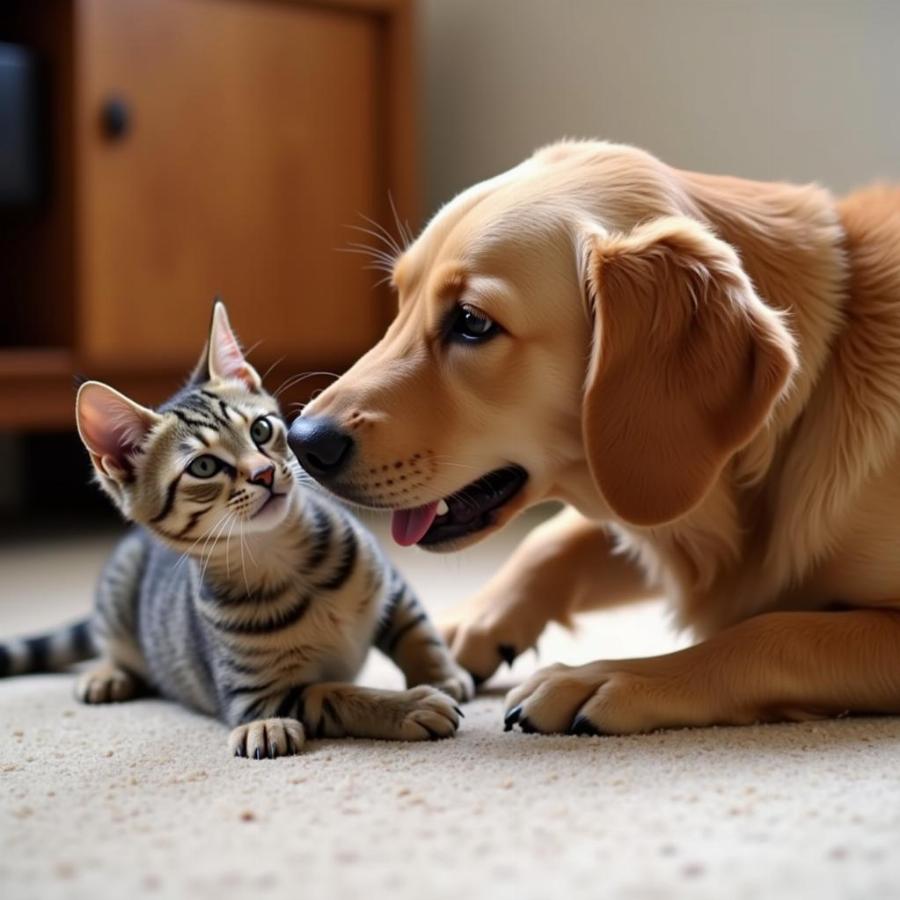Thinking about bringing both a Chesapeake Bay Retriever and a cat into your home? It’s a question many animal lovers ponder, and the answer, like most things pet-related, isn’t a simple yes or no. Chesapeake Bay Retrievers, known for their strong retrieving instincts and energetic nature, can coexist peacefully with cats, but it requires careful introduction, consistent training, and a good understanding of both species. This article will delve into the dynamics of Chesapeakes and cats, offering insights and guidance to help you create a harmonious multi-pet household.
Understanding the Chesapeake Bay Retriever
Chesapeakes are intelligent, loyal, and devoted companions. Bred for waterfowl retrieving, they possess a strong prey drive, which can sometimes be misinterpreted as aggression towards smaller animals. This doesn’t mean they can’t live with cats; it simply means you need to be aware of this instinct and manage it appropriately. Early socialization is key. Puppies exposed to cats from a young age are more likely to accept them as part of the family.
Introducing Your Chesapeake to a Cat
Introducing a Chesapeake to a cat requires patience and a slow, controlled approach. Start by keeping them separated, allowing them to get used to each other’s scents. Short, supervised visits can then be introduced, gradually increasing the duration as they become more comfortable. Positive reinforcement is crucial. Reward calm behavior around the cat with treats and praise. Never force interactions. Let them develop their relationship at their own pace.
Training Your Chesapeake for Cat-Friendly Coexistence
Training is essential for a successful Chesapeake-cat relationship. Basic obedience commands like “sit,” “stay,” and “leave it” are crucial. These commands will help you manage your dog’s behavior around the cat, especially during those initial encounters. Consistency is key. Reinforce these commands regularly, even when the cat isn’t present. This will help your Chesapeake understand the boundaries and expectations you’ve set.
Choosing the Right Cat for a Chesapeake Household
While a Chesapeake can adapt to living with a cat, certain cat personalities might be better suited for this dynamic. Confident, independent cats who aren’t easily intimidated are often a good match. Kittens can also adapt well, learning to navigate the Chesapeake’s energy from a young age.
 Chesapeake Bay Retriever Playing Gently with a Cat
Chesapeake Bay Retriever Playing Gently with a Cat
Ensuring a Safe and Happy Environment for Both Pets
Creating a safe and happy environment for both your Chesapeake and your cat requires some planning. Provide your cat with plenty of vertical space, such as cat trees or shelves, to escape to if they feel overwhelmed. Separate feeding areas and litter boxes are also essential to avoid resource guarding. Ensure both pets have their own toys and designated resting areas. This will help them feel secure and minimize competition.
Can a Chesapeake Bay Retriever live with a cat?
Yes, a Chesapeake Bay Retriever can live with a cat, but it requires careful planning and execution.
How do I introduce my Chesapeake to my cat?
Introduce them slowly and under supervision, rewarding calm behavior. Start with scent swapping and progress to short, supervised visits.
What type of cat is best for a Chesapeake household?
Confident, independent cats, or kittens who can adapt to the Chesapeake’s energy are often the best fit.
What training is necessary for a Chesapeake living with a cat?
Basic obedience commands like “sit,” “stay,” and “leave it” are crucial for managing the dog’s behavior around the cat.
How can I create a safe environment for both pets?
Provide vertical space for the cat, separate feeding areas, and designated resting spots to minimize competition and ensure both pets feel secure.
Conclusion
Bringing a Chesapeake Bay Retriever and a cat into the same home can be a rewarding experience. With careful planning, consistent training, and a commitment to creating a harmonious environment, you can foster a loving and respectful relationship between these two very different species. Remember, patience and understanding are key to a successful Chesapeake cats and dogs combination.
FAQs
- Are Chesapeakes naturally aggressive towards cats? No, but their prey drive can be mistaken for aggression. Early socialization is vital.
- Can an adult Chesapeake learn to live with a cat? Yes, but it may require more time and patience than with a puppy.
- Is it ever too late to introduce a cat to a Chesapeake? It’s rarely too late, but older dogs with established habits may require professional guidance.
- What if my Chesapeake chases my cat? Redirect their attention with a toy or command and reinforce calm behavior. Consult a professional trainer if the behavior persists.
- How do I know if my cat is stressed by the Chesapeake? Look for signs like hiding, hissing, or changes in appetite.
Further Reading on Beaut Dogs
- Chesapeake Bay Retriever Breed Profile
- Understanding Cat Behavior
- Creating a Multi-Pet Household
Beaut Dogs is your go-to resource for all things dog-related! We provide comprehensive information and expert advice on various breeds, including the Chesapeake Bay Retriever. For personalized guidance and answers to your specific questions, please contact us at [email protected]. We’re here to help you create a happy and healthy home for your furry friends. Visit us at https://beautdogs.com.